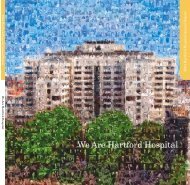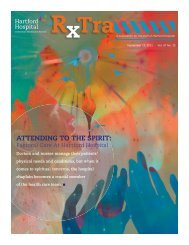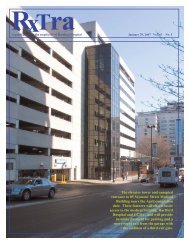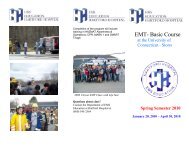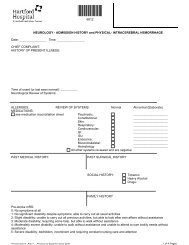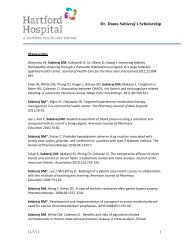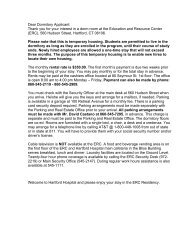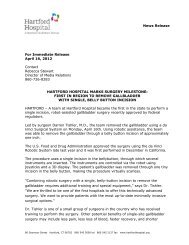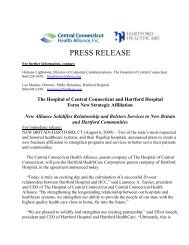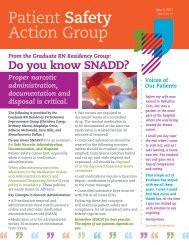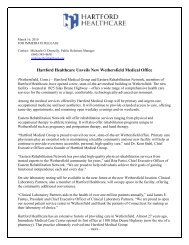Hartford Hospital/UCONN Cardiovascular Fellowship - PROGRAM ...
Hartford Hospital/UCONN Cardiovascular Fellowship - PROGRAM ...
Hartford Hospital/UCONN Cardiovascular Fellowship - PROGRAM ...
You also want an ePaper? Increase the reach of your titles
YUMPU automatically turns print PDFs into web optimized ePapers that Google loves.
<strong>PROGRAM</strong> DESCRIPTION<br />
CARDIOVASCULAR FELLOWSHIP<br />
HARTFORD HOSPITAL/UNIVERSITY OF CONNECTICUT<br />
Program Director: Gary V. Heller, MD, Ph.D. Associate Director: Ravi Yarlagadda, MD<br />
80 Seymour Street, P.O. Box 5037<br />
<strong>Hartford</strong>, CT 06102-5037<br />
Director, Cardiology:<br />
Associate Director, Cardiology:<br />
Director, <strong>Cardiovascular</strong> Research:<br />
Paul D. Thompson, MD<br />
Gary V. Heller, MD, Ph.D.<br />
Paul D. Thompson, MD<br />
Full-Time Faculty: Paul D. Thompson, MD Gary V. Heller, MD, Ph.D.<br />
Jeffrey Kluger, MD Ravi Yarlagadda, MD<br />
Christopher Clyne, MD Justin B. Lundbye, MD<br />
Judy Mangion, MD Francis J. Kiernan, MD<br />
CLINICAL FACULTY:<br />
Interventional Cardiology<br />
Francis J. Kiernan, MD, Director<br />
Jeffrey Hirst, MD<br />
Charles A. Primiano, MD<br />
Daniel Fram, MD<br />
Raymond G. McKay, MD<br />
Joseph Mitchel, DO<br />
Echocardiography<br />
Judy Mangion, MD, Director<br />
Heart Rhythm Management & Interventional Electrophysiology<br />
Jeffrey Kluger, MD, Director<br />
Christopher Clyne, MD, Director,<br />
Interventional Electrophysiology<br />
Ravi Yarlagadda, MD<br />
Nuclear Cardiology<br />
Gary V. Heller, MD, Ph.D., Director<br />
Preventive Cardiology<br />
Paul D. Thompson, MD, Director<br />
Ellen Dornelas, Ph.D.<br />
<strong>Hospital</strong>ists<br />
Hermal Kadakia, MD<br />
Aravind Kokkirala, MD<br />
Richard Ruffin, MD<br />
Cardiology Attendings<br />
Peter Barwick, MD<br />
James Cardon, MD<br />
David M. Casey, MD<br />
James Dougherty, MD<br />
Brett Duncan, MD<br />
Melissa Ferraro-Borgida, MD<br />
Carol Gemayel, MD<br />
Steve Goldblatt, MD<br />
Steve Horowitz, MD<br />
James Kallal, MD<br />
Stephen Kastoff, MD<br />
Anthony LaSala, MD<br />
Exercise Laboratory<br />
Charles A. Primiano, MD, Director<br />
Coronary Intensive Care Unit<br />
Justin B. Lundbye, MD, Director<br />
Shafeeq Ahmed, MD<br />
Ravi Kalaga, MD<br />
Reza Mansoor, MD<br />
Maha Mikhail, MD<br />
Alfredo Nino, MD<br />
Dariush Owlia, MD<br />
Lawrence Pareles, MD<br />
Ronald Pariser, MD<br />
Asad Rizvi, MD<br />
Michael Rossi, MD<br />
Fred Rubin, MD<br />
Donald Ruffett, MD<br />
Kevin Tally, MD<br />
Jeffrey Walden, MD
General Description<br />
2<br />
The <strong>Cardiovascular</strong> Disease Program at <strong>Hartford</strong> <strong>Hospital</strong>/University of Connecticut is a threeyear<br />
program specifically designed to prepare cardiovascular fellows for the practice of<br />
Cardiology. While in the three-year program, fellows receive training in basic cardiovascular<br />
diseases, clinical cardiology, and subspecialty practices. This is accomplished in several ways<br />
including clinical rotations which allows exposure to cardiovascular related diseases and<br />
problems, didactic sessions covering basic mechanisms of cardiovascular diseases, dedicated<br />
research months and subspecialty rotations. During the clinical rotations, the cardiovascular<br />
disease fellow interviews, examines and formulates basic evaluations in patients with<br />
cardiovascular related illnesses. During subspecialty training, cardiovascular disease fellows<br />
are exposed to the practices of cardiac catheterization, preventive cardiology, arrhythmias,<br />
nuclear cardiology, echocardiography, cardiovascular surgery, pacemaker techniques and<br />
interventional electrophysiology. During the third year, the cardiovascular disease fellow<br />
chooses either an invasive or non-invasive track for additional training in one of those areas. At<br />
the completion of the cardiovascular disease program, the fellow is qualified to enter the<br />
practice of cardiovascular diseases either in the invasive, non-invasive or clinical areas.<br />
Although, not specifically part of the cardiovascular disease program, interested fellows may<br />
choose a fourth year subspecializing in various aspects of cardiology in hopes of pursuing an<br />
academic career. The Interventional Cardiology Program at <strong>Hartford</strong> <strong>Hospital</strong> is ACGME<br />
approved and is an option for further training.<br />
The research experience in the cardiovascular disease program is designed to allow the fellow<br />
ample exposure to the process of designing, performing data analysis, and manuscript<br />
preparation of a research project. Research is begun in the first year specifically to allow the<br />
cardiovascular disease fellow opportunity to gain skill and knowledge in the performance of<br />
cardiovascular disease research and to allow time for completion of study. The early exposure<br />
to research also allows the fellow the opportunity to evaluate the possibility of entering<br />
academic cardiology. Fellows engaged in research are expected to prepare results for abstract<br />
and manuscript submission. Local hospital funding is available for support of projects, and<br />
several attending physicians have national support for studies. Dr. Paul D. Thompson is<br />
supervisor of the research experience for the fellows.<br />
<strong>Fellowship</strong> Length and Rotations
3<br />
The University of Connecticut/<strong>Hartford</strong> <strong>Hospital</strong> <strong>Cardiovascular</strong> Disease <strong>Fellowship</strong> Program<br />
consists of a 3-year blend of Clinical Cardiology, subspecialty training, and research. <strong>Hartford</strong><br />
<strong>Hospital</strong> is one of the largest cardiovascular volume hospitals in the New England area and<br />
exposes the fellows to a wide range of cases, which will be encountered in future cardiovascular<br />
practice.<br />
The 1st year is primarily clinical and includes the consultation service, coronary care unit, and<br />
subspecialties of arrhythmia, echocardiography, nuclear cardiology, cardiac catheterization, and<br />
preventive cardiology. One month is set aside for research. The duties of the fellows are to<br />
gain knowledge in the various subspecialties and how they interact with clinical cardiology.<br />
Early exposure to subspecialties that separates the cardiology fellow from their internal<br />
medicine background is a key component of the program prior to CICU and Consultation<br />
rotations.<br />
The 2nd year is a similar format to the 1st year rotations with the exception of 2 months of<br />
research and elective time. In the 2nd year the fellow has more in depth exposure to clinical<br />
cardiovascular medicine as well as each of the subspecialties, and assumes greater<br />
responsibilities.<br />
The 3rd year fellow can choose two pathways between invasive and non-invasive cardiology. If<br />
the fellow chooses the invasive pathway, 9 months are spent in the cardiac catheterization<br />
laboratory and 3 months in research. A non-invasive pathway includes rotations in nuclear<br />
cardiology, echocardiography, and 3 months of research, which can be tailored to the individual<br />
fellow needs.<br />
Conference Schedule<br />
The fellows attend daily conferences, which include non-invasive cardiology, cardiac<br />
catheterization, arrhythmia/ECG, journal club, cardiology grand rounds, lipid management,<br />
research combined surgical/cardiac rounds and chief’s rounds. . For each lecture series,<br />
presentations include basic descriptions of the subspecialty as well as clinical discussions.<br />
Cardiology grand rounds consists of nationally recognized speakers discussing all relevant<br />
topics in cardiology. Once a month the fellows have the opportunity to meet with and present<br />
cases to an outside expert. In addition, the fellows undergo a 2-month course in cardiovascular<br />
diseases in July and August of each year. This course is designed to acquaint the incoming
4<br />
fellows with acute situations they may encounter as well as topics that may not be covered in<br />
other venues.<br />
EDUCATIONAL <strong>PROGRAM</strong><br />
Clinical Cardiology Service: The Clinical Cardiology Service consists of both the Coronary<br />
Intensive Care Unit (CICU) and the Consultation Service. The concept is to provide a strong<br />
basis of clinical training for the fellow.<br />
CICU: The cardiology fellow is responsible for training of residents and supervision of all<br />
patients in the CICU. Approximately 80% of patients admitted to the Coronary Care Unit are in<br />
conjunction with private attendings, another 20% of patients are on the Cardiology Service. The<br />
Cardiology Fellow is indirectly responsible for the general well being of all patients but directly<br />
responsible for all Cardiology Service patients in conjunction with the Cardiology Service<br />
attending. The fellow in conjunction with the CICU attending rounds daily with the house staff<br />
providing important educational opportunities. The cardiology fellow is responsible for all<br />
cardiac emergencies in the hospital during the rotation.<br />
Consultation Service: The Consultation Service at <strong>Hartford</strong> <strong>Hospital</strong> is responsible for all<br />
requests for cardiology consultations by in-hospital services. These services include internal<br />
medicine, surgery, obstetrics/gynecology, neurosurgery, etc. These consultations include such<br />
topics as preoperative evaluation, cardiac contusion, management of acute coronary<br />
syndromes, and congestive heart failure. The Cardiology Fellow in conjunction with the service<br />
attending evaluates all patients, performs physical examinations, and develops a diagnostic and<br />
management strategy. The attending physician with the Cardiology Fellow sees and evaluates<br />
all patients who undergoes cardiac consultation. In addition, the Cardiology Fellow is<br />
responsible the Chief’s Cardiology Service. These are admitted patients who have no assigned<br />
physician. Up to 4 patients may be admitted with such diagnoses as acute coronary syndrome,<br />
congestive heart failure, bacterial endocarditis, and other cardiovascular related illnesses. An<br />
intern from the CICU rotation follows the patient with the Cardiology Fellow.<br />
Outpatient <strong>Cardiovascular</strong> Clinic: An important part of the cardiovascular fellowship is the<br />
Outpatient <strong>Cardiovascular</strong> Clinic. Sessions are held Wednesday morning and Thursday<br />
afternoon on a weekly basis. <strong>Cardiovascular</strong> Fellows are assigned to one of these times and<br />
continue that time throughout the year. Unassigned patients who choose to receive services at<br />
the Brownstone Clinic are seen by Cardiology Fellows. These include patients with chronic<br />
stable angina, multiple valvular disorders, congestive heart failure, and arrhythmias. An<br />
attending physician is assigned to the clinic. The attending physician examines, and develops
5<br />
management strategies with the <strong>Cardiovascular</strong> Fellow. In addition to the unassigned patient,<br />
any recently hospitalized patient is followed in the <strong>Cardiovascular</strong> Clinic. Patients are also<br />
referred from the Internal Medicine Clinics seen in the same building.<br />
After an initial evaluation, the patients seen by the Cardiology Fellow may be followed for the<br />
duration of the <strong>Cardiovascular</strong> Fellow’s tenure. It is expected that the Cardiology Fellow will<br />
follow any patients from the <strong>Cardiovascular</strong> Clinic who are hospitalized. The fellow in<br />
conjunction with the Consultation/CICU fellow will assist in diagnostic and management<br />
decisions.<br />
The Outpatient <strong>Cardiovascular</strong> Clinic is a rich and rewarding part of the <strong>Cardiovascular</strong><br />
<strong>Fellowship</strong>. This experience gives the Fellows long-term longitudinal exposure to further refine<br />
management strategies over time. <strong>Hartford</strong> <strong>Hospital</strong> is a primary and tertiary care center with<br />
referrals from the northern Connecticut area.<br />
Heart Rhythm Management/Interventional Electrophysiology Service: Heart Rhythm<br />
Management Services at <strong>Hartford</strong> <strong>Hospital</strong> consist of a diagnostic and interventional<br />
electrophysiology laboratories, Syncope Center, one of the largest device clinics in the region<br />
(8,000 encounters/year) and a busy consultation service. During the first year the fellow<br />
performs consultations in conjunction with the attending physician and assists in various studies<br />
such as electrophysiologic testing, tilt-table testing, holter monitoring and arrhythmia<br />
recognition. Fellows attend pacemaker and ICD clinics and learn device interrogation and<br />
programming.<br />
The heart rhythm management service is a busy one with over 1,000 consultations annually.<br />
EP studies and tilt-table tests are performed on a daily basis. Catheter ablation and<br />
biventricular pacing procedures are on the cutting edge of interventional electrophysiology. The<br />
goals of the first year are to become skilled at identification and treatment of arrhythmias,<br />
understand the role of electrophysiology and tilt studies and to perform device interrogation.<br />
The 2 nd year fellow performs at least one month and possibly two months of advanced training<br />
and is expected to be more skilled in the evaluation of patients with arrhythmias as well as the<br />
performance of related procedures such as tilt-table testing, EPS, and assisting in catheter<br />
ablations.<br />
Cardiac Catheterization: <strong>Hartford</strong> <strong>Hospital</strong> has an active catheterization program. The facility<br />
consists of four adult cardiac catheterization suites equipped with digital x-ray systems. On an
6<br />
annual basis approximately 3700 procedures are performed including 1200 coronary<br />
interventional procedures. The patients who are referred to the laboratory represent a broad<br />
spectrum of cardiac pathology. The procedures offered include diagnostic cardiac<br />
catheterization, balloon angioplasty, coronary stent placement and the use of new and<br />
investigational devices. The vast majority of patients who present to <strong>Hartford</strong> <strong>Hospital</strong> with<br />
acute myocardial infarction are referred to the laboratory for primary intervention. The teaching<br />
faculty consists of seven cardiologists who are geographically based in the laboratory.<br />
Fellows in the first and second year of training are exposed to diagnostic right and left heart<br />
catheterization including coronary angiography. They participate in the pre-procedure<br />
evaluation of the patient and participate with the attending in the performance of the procedure<br />
and interpretation of results. The major emphasis in the first two years is acquiring knowledge<br />
of basic coronary anatomy and hemodynamics. Fellows in their third year can elect to spend<br />
nine months in the laboratory in order to obtain in-depth training in cardiac catheterization.<br />
<strong>Hartford</strong> <strong>Hospital</strong> also offers a dedicated fourth year of training in interventional cardiology, an<br />
ACGME approved program.<br />
In addition to clinical activities and teaching, the fellows have an opportunity to participate in the<br />
research activities of the laboratory. There is an active patient database that can be used for<br />
clinical research. The laboratory is involved with testing of new devices as part of clinical trials.<br />
There is also an animal facility for basic research. These activities have resulted in a number of<br />
presentations and publications by cardiology fellows.<br />
Echocardiography Laboratory: The Echocardiography Laboratory performs over 7,000<br />
studies annually. Equipment includes state of the art Siemens and Phillips systems with<br />
emergency imaging performed 24 hours a day. The Echocardiography section provides<br />
comprehensive didactic and clinical training in the performance and interpretation of<br />
Echocardiograms. Training includes hands-on acquisition of transthoracic images with digital<br />
and tape storage and retrieval technology. The basics of ultrasound and Doppler physics are<br />
taught at length in didactic sessions. The fellow will become adept at performance and<br />
interpretation of complete transthoracic echocardiograms. Tools such as M-mode, second<br />
harmonic imaging, contrast echocardiography and power Doppler will be used on routine clinical<br />
examinations to enhance the diagnostic information obtained from the test. The first year fellow<br />
will spend 2 months in Echocardiography and will be expected to perform transthoracic<br />
echocardiograms on call with the assistance and backup of a Cardiac Sonographer and<br />
Attending. Research participation is encouraged. The objective of the first year in
7<br />
Echocardiography is to become adept at the utilization of echocardiography in clinical practice<br />
as a diagnostic tool.<br />
The second year fellow will continue with regularly scheduled didactic sessions reviewing the<br />
basic principles of Echocardiography. The fellow will continue to advance manual skills in the<br />
independent performance of transthoracic echocardiograms. The fellow will also be asked to<br />
regularly interpret complete transthoracic echocardiograms with a focus on providing a clinical<br />
diagnosis and a thorough interrogation of associated cardiac abnormalities. The objective of<br />
the second year in Echocardiography is to become adept at the independent performance and<br />
interpretation of complete transthoracic echocardiographic studies.<br />
The objective of the third year noninvasive Echocardiography program is to add procedural<br />
skills. The fellow will be trained in the performance of transesophageal and stress<br />
echocardiography (exercise treadmill and dobutamine stress). The fellow will continue active<br />
involvement in the didactic sessions and clinical performance and interpretation of transthoracic<br />
echocardiograms. The fellow who chooses the noninvasive path will spend 3-6 months in<br />
Echocardiography. A supplemental program is available for those who wish to sit for the ASE<br />
examination in Echocardiography.<br />
Nuclear Cardiology: The Nuclear Cardiology Laboratory is an integral part of the Cardiology<br />
Division and performs over 3,500 nuclear cardiology procedures annually. Equipment includes<br />
3 dual head cameras on site and 3 satellite office locations as well as stress testing with oxygen<br />
consumption equipment. The Nuclear Cardiology Laboratory is part of the Cardiology Division<br />
and directed by a board certified nuclear cardiologist. Procedures include a myocardial<br />
perfusion imaging associated with gated-SPECT imaging, radionuclide ventriculography, shunt<br />
studies, myocardial infarct avid imaging as well as several experimental procedures with new<br />
radiopharmaceuticals in the development stages. The pharmacologic stress testing includes<br />
vasodilator stress with both dipyridamole and adenosine as well as inotropic stress with<br />
dobutamine.<br />
Cardiology fellows in the first and second year of training are exposed to four months of<br />
dedicated nuclear cardiology which afford them ample opportunity to perform exercise and<br />
pharmacology stress testing, and interpret nuclear cardiology procedures with an attending<br />
physician. The indications for the procedure as well as clinical implications of findings are<br />
discussed. A Non-Invasive conference shared by Echocardiography is held weekly. During the<br />
second year the fellow is expected to spend time with technologists to gain an understanding of<br />
image acquisition processing and quality control. Time is spent learning technical problems that
8<br />
can occur during the acquisition and processing of nuclear procedures. Fellows in the third year<br />
who opt to seek certification in nuclear cardiology may enroll in the University of Connecticut<br />
Nuclear Medicine Division Radiation Physics Course to gain certification of the 200 didactic<br />
hours required by the Nuclear Regulatory Commission. The third year fellow may gain enough<br />
participation for either Level 2 or Level 3 by ACC guidelines. The Level 3 accreditation requires<br />
one full year of participation in nuclear cardiology and allows the fellow to fully operate a nuclear<br />
cardiology laboratory. An optional fourth year of dedicated research is also possible.<br />
Preventive Cardiology: The Preventive Cardiology experience is integrated into the fellowship<br />
program with the concept that all well-trained cardiologists should know the principles of primary<br />
and secondary heart disease prevention. Preventive Cardiology includes the Cholesterol<br />
Management Center, the Nicotine Treatment Center, the Cardiac Rehabilitation Program, and<br />
the Exercise Research Program. First year fellows spend a one-month rotation in Preventive<br />
Cardiology. The fellow spends time in the Cholesterol Management Center addressing difficult<br />
lipid cases, attends smoking cessation clinic, and assists with Cardiac Rehabilitation. There are<br />
also didactic sessions provided to all fellows monthly to discuss preventive strategies. By the<br />
completion of the fellowship program, the fellow will know advanced lipid physiology, how the<br />
lipid lowering agents work, how to counsel patients in smoking cessation, the principles of<br />
exercise physiology and how they apply to active patients, and basic hypertension<br />
management.<br />
Research: The ACGME requires a minimum of 6 months research during the cardiovascular<br />
fellowship program. Each fellow is therefore expected to participate in active research projects<br />
during his/her fellowship period. Ample opportunity is provided for such experience beginning in<br />
the first year. Each year the fellow is expected to become more independent in his/her research<br />
but always with the guidance of a mentor. The research fellow is at liberty to choose any<br />
attending physician they wish for such guidance. The research environment at <strong>Hartford</strong><br />
<strong>Hospital</strong> is extremely strong with participation in both independent and multi-center research<br />
projects. The fellows are encouraged to participate in independent research during the<br />
fellowship years. Funding is available if necessary through the Research Administration at<br />
<strong>Hartford</strong> <strong>Hospital</strong>. During the second and third years, if research has progressed, the fellow is<br />
encouraged to submit abstracts for the American Heart Association and American College of<br />
Cardiology meetings in addition subspecialty meeting applications are also possible. If<br />
accepted the fellow is expected to prepare the abstracts for presentation and move towards<br />
manuscript preparation. Recent publications by the Division of Cardiology are provided to<br />
demonstrate the productivity of the Division.
9<br />
The fellows’ progress is reviewed by a Residency Committee, which meets twice a year. In<br />
addition, the Program Director meets every 3 months with the fellow to discuss their evaluations<br />
by the attendings. The fellows’ research progress is also discussed during this time. The<br />
Program Director meets monthly with all fellows to discuss new information, problems and<br />
successes of the cardiovascular disease program.
10<br />
R e c e n t P u b l i c a t i o n s b y t h e<br />
C a r d i o l o g y D i v i s i o n<br />
Gillespie EL, Gryskiewicz A, White CM, Kluger J, Humphrey C, Horowitz S, Coleman CI. Effect of<br />
aprotinin on the frequency of postoperative atrial fibrillation or flutter. Am J Health-Syst Pharm<br />
2005;62:1370-74.<br />
Giedrimas A, Guertin D, Clyne CA, Giedrimiene D, Kluger J. Outcomes of ICD therapy for<br />
primary and secondary prevention indications. Materials of 26 th Annual Scientific Sessions of<br />
Heart Rhythm Society. Heart Rhythm J, v. 2, 2005, S168.<br />
Giedrimiene D, Guertin D, Clyne CA, Kluger J. Clinical predictors of mortality in patients with<br />
syncope and ICD therapy. Materials of 26 th Annual Scientific Sessions of Heart Rhythm Society.<br />
Heart Rhythm J, v. 2, 2005, S324.<br />
Min B, McBride BF, Kardas MJ, Ismali A. Sinha V, Kluger J, White, CM. Electrocardiographic<br />
effects of an Ephedra free multicomponent weight loss supplement in healthy volunteers.<br />
Pharmacotherapy 2005;25:654-9.<br />
Gillespie EL, Perkerson KA, White CM, Kluger J, Coleman CI. Effect of Aprotinin on the incidence<br />
of postoperative atrial fibrillation after cardiothoracic surgery. American Journal of Health-<br />
System Pharmacy 2005;62:1370-4.<br />
Min B, McBride BF, Ismali, Kardas MJ, Sinha V, Kluger J, White CM. The hemodynamic effects<br />
of an Ephedra free multicomponent weight loss supplement in healthy volunteers. American<br />
Journal of Health-System Pharmacy 2005;62:1582-5.<br />
Henyan NH, Gillespie EL, White CM, Kluger J, Coleman CI. The impact of intravenous<br />
Magnesium on post-cardiothoracic surgery atrial fibrillation and length of hospital stay: A Meta-<br />
Analysis. Annals of Thoracic Surgery 2005;80:2402-2406.<br />
Kalus JS, White CM, Caron MF, Guertin D, McBride BF, Kluger J. The impact of elevations in<br />
catecholamine concentrations on defibrillation threshold in patients with implanted cardioverter<br />
defibrillators. The Defibrillation Threshold Effects of Catecholamines Trial (DTECT). PACE<br />
2005;28:1147-56.<br />
McBride BF, Min B, Guertin D, Kluger J, Henyan N, Coleman CI, Silver B, White CM. An<br />
evaluation of the impact of oral Magnesium Lactate on the corrected QT interval of patients<br />
receiving Sotalol or Dofetilide to prevent atrial or ventricular tachyarrhythmia recurrence.<br />
Annals Noninvasive Electrocardiology. 2006;11:163-9.<br />
Min B, Cios D, Kluger J, White CM. The hemodynamic and electrocardiographic effect of bitter<br />
orange extract in healthy volunteers. Pharmacotherapy. 2005;25:1719-24<br />
Kapetanopoulous A, Peckham G, Kiernan F, Clyne C, Kluger, J, Migeed MA. Implantation of a<br />
biventricular pacing and defibrillator device via a persistent left superior vena cava. J Cardiovasc<br />
Med 2006 7;430-433
11<br />
Wiviott SD, Antman EM, Winters KJ, Weerakkody G, Murphy SA, Behounek BD, Carney RJ,<br />
Lazzam C, McKay RG, McCabe CH, Braunwald E; JUMBO-TIMI 26 Investigators. Randomized<br />
comparison of prasugrel (CS-747, LY640315), a novel thienopyridine P2Y12 antagonist, with<br />
clopidogrel in percutaneous coronary intervention: results of the Joint Utilization of Medications<br />
to Block Platelets Optimally (JUMBO)-TIMI 26 trial.Circulation. 2005;111(25):3366-73<br />
Elkoustaf RA, Mamkin I, Mather JF, Murphy D. Hirst JA, Kiernan FJ, McKay RG. Comparison of<br />
results of percutaneous coronary intervention for non-ST-elevation acute myocardial infarction<br />
or unstable angina in men versus women. Am J Cardiol 2006;98:182-6<br />
Coleman CI, McKay RG, Boden WE, Mather JF, White CM. Effectiveness and cost-effectiveness<br />
of facilitated percutaneous coronary intervention compared with primary coronary intervention<br />
in patients with ST-segment elevation myocardial infarction transferred from community<br />
hospitals. Clinical Therapeutics 2006;28(7):1054-1062.<br />
Seip RL, Otvos J, Bilbie C, Tsongalis GJ, Miles M, Zoeller R, Visich P, Gordon P, Angelopoulos TJ,<br />
Pescatello L, Moyna N, Thompson PD. The effect of apolipoprotein E genotype on serum<br />
lipoprotein particle response to exercise. Atherosclerosis. 2006 Sep;188(1):126-33.<br />
Guidry MA, Blanchard BE, Thompson PD, Maresh CM, Seip RL, Taylor AL, Pescatello LS.The<br />
influence of short and long duration on the blood pressure response to an acute bout of<br />
dynamic exercise. Am Heart J. 2006 Jun;151(6):1322.e5-12.<br />
Pescatello LS, Kostek MA, Gordish-Dressman H, Thompson PD, Seip RL, Price TB, Angelopoulos<br />
TJ, Clarkson PM, Gordon PM, Moyna NM, Visich PS, Zoeller RF, Devaney JM, Hoffman EP. ACE<br />
ID genotype and the muscle strength and size response to unilateral resistance training. Med Sci<br />
Sports Exerc. 2006 Jun;38(6):1074-81.<br />
Urso ML, Scrimgeour AG, Chen YW, Thompson PD, Clarkson PM. Analysis of Human Skeletal<br />
Muscle after 48h Immobilization Reveals Alterations in mRNA and Protein for Extracellular Matrix<br />
Components. J Appl Physiol. 2006 Jun 8<br />
Baghdasarian SB, Thompson PD. How safe are very low LDL cholesterol levels?<br />
Nat Clin Pract Cardiovasc Med. 2006 Jun;3(6):306-7.<br />
Clarkson PM, Kearns AK, Rouzier P, Rubin R, Thompson PD. Serum creatine kinase levels and<br />
renal function measures in exertional muscle damage. Med Sci Sports Exerc. 2006 pr;38(4):623-<br />
7.<br />
Kapetanopoulos A, Kluger J, Maron BJ, Thompson PD. The congenital long QT syndrome and<br />
implications for young athletes. Med Sci Sports Exerc. 2006 May;38(5):816-25.<br />
Pelliccia A, Thompson PD. The genetics of left ventricular remodeling in competitive athletes.<br />
J Cardiovasc Med (Hagerstown). 2006 Apr;7(4):267-70. Review.<br />
Roberts BH, Thompson PD. Is there evidence for the evidence-based guidelines for<br />
cardiovascular disease prevention in women? Gend Med. 2006 Mar;3(1):5-12. No abstract<br />
available.<br />
Thompson PD, Clarkson PM, Rosenson RS; The National Lipid Association Statin Safety Task<br />
Force Muscle Safety Expert Panel. An assessment of statin safety by muscle experts.<br />
Am J Cardiol. 2006 Apr 17;97(8A):69C-76C.
Thompsen J, Thompson PD. A systematic review of LDL apheresis in the treatment of<br />
cardiovascular disease. Atherosclerosis. 2006 Mar 16;<br />
12<br />
Blanchard BE, Tsongalis GJ, Guidry MA, LaBelle LA, Poulin M, Taylor AL, Maresh CM, Devaney J,<br />
Thompson PD, Pescatello LS. RAAS polymorphisms alter the acute blood pressure response to<br />
aerobic exercise among men with hypertension. Eur J Appl Physiol. 2006 May;97(1):26-33.<br />
Ouyang P, Tardif JC, Herrington DM, Stewart KJ, Thompson PD, Walsh MN, Bennett SK,<br />
Heldman AW, Tayback MA, Wang NY; for the Estrogen And Graft Atherosclerosis Research<br />
(EAGAR) investigators. Randomized trial of hormone therapy in women after coronary bypass<br />
surgery Evidence of differential effect of hormone therapy on angiographic progression of<br />
disease in saphenous vein grafts and native coronary arteries. Atherosclerosis. 2006 Jan 23;<br />
Thompson PD, Tsongalis GJ, Ordovas JM, Seip RL, Bilbie C, Miles M, Zoeller R, Visich P, Gordon<br />
P, Angelopoulos TJ, Pescatello L, Moyna N. Angiotensin-converting enzyme genotype and<br />
adherence to aerobic exercise training. Prev Cardiol. 2006 Winter;9(1):21-4.<br />
Patel MD, Thompson PD. Phytosterols and vascular disease. Atherosclerosis. 2006<br />
May;186(1):12-9.<br />
Ruano G, Thompson PD, Windemuth A, Smith A, Kocherla M, Holford TR, Seip R, Wu AH.<br />
Physiogenomic analysis links serum creatine kinase activities during statin therapy to vascular<br />
smooth muscle homeostasis. Pharmacogenomics. 2005 Dec;6(8):865-72.<br />
Juszczyk MA, Seip RL, Thompson PD. Decreasing LDL cholesterol and medication cost with<br />
every-other-day statin therapy. Prev Cardiol. 2005 Fall;8(4):197-9.<br />
Urso ML, Clarkson PM, Hittel D, Hoffman EP, Thompson PD. Changes in ubiquitin proteasome<br />
pathway gene expression in skeletal muscle with exercise and statins. Arterioscler Thromb Vasc<br />
Biol. 2005 Dec;25(12):2560-6.<br />
McKenney JM, Davidson MH, Saponaro J, Thompson PD, Bays HE. Use of a treatment algorithm<br />
to achieve NCEP ATP III goals with atorvastatin. J Cardiovasc Pharmacol. 2005 Nov;46(5):594-<br />
9.<br />
Thompson, PD. Exercise prescription and proscription for patients with coronary artery disease.<br />
Circulation. 2005 Oct 11;112(15):2354-63. Review.<br />
Thompson PD, Kiernan F. Prevention of heart disease in female athletes. Med Sci Sports Exerc.<br />
2005 Aug;37(8):1440-3.<br />
Levine BD, Pelliccia A, Thompson PD, Douglas PS, Fu Q, Di Paolo F, Kiernan F, Zasadil M. The<br />
cardiovascular evaluation of women athletes. Med Sci Sports Exerc. 2005 Aug;37(8):1431-2.<br />
Ruano G, Seip RL, Windemuth A, Zollner S, Tsongalis GJ, Ordovas J, Otvos J, Bilbie C, Miles M,<br />
Zoeller R, Visich P, Gordon P, Angelopoulos TJ, Pescatello L, Moyna N, Thompson PD.<br />
Apolipoprotein A1 genotype affects the change in high density lipoprotein cholesterol<br />
subfractions with exercise training. Atherosclerosis. 2006 Mar;185(1):65-9.<br />
Hubal MJ, Gordish-Dressman H, Thompson PD, Price TB, Hoffman EP, Angelopoulos TJ, Gordon<br />
PM, Moyna NM, Pescatello LS, Visich PS, Zoeller RF, Seip RL, Clarkson PM. Variability in muscle<br />
size and strength gain after unilateral resistance training. Med Sci Sports Exerc. 2005<br />
Jun;37(6):964-72.
Kasapis C, Thompson PD. The effects of physical activity on serum C-reactive protein and<br />
inflammatory markers: a systematic review. J Am Coll Cardiol. 2005 May 17;45(10):1563-9.<br />
Thompson PD, Balady GJ, Chaitman BR, Clark LT, Levine BD, Myerburg RJ. Task Force 6:<br />
coronary artery disease. J Am Coll Cardiol. 2005 Apr 19;45(8):1348-53.<br />
Maron BJ, Douglas PS, Graham TP, Nishimura RA, Thompson PD. Task Force 1: preparticipation<br />
screening and diagnosis of cardiovascular disease in athletes. J Am Coll Cardiol. 2005 Apr<br />
19;45(8):1322-6. Review.<br />
Levine BD, Thompson PD. Marathon maladies. N Engl J Med. 2005 Apr 14;352(15):1516-8.<br />
Jurado J, Thompson PD. Prevention of coronary artery disease in cancer patients. Pediatr Blood<br />
Cancer. 2005 Jun 15;44(7):620-4. Review.<br />
Clarkson PM, Devaney JM, Gordish-Dressman H, Thompson PD, Hubal MJ, Urso M, Price TB,<br />
Angelopoulos TJ, Gordon PM, Moyna NM, Pescatello LS, Visich PS, Zoeller RF, Seip RL, Hoffman<br />
EP. ACTN3 genotype is associated with increases in muscle strength in response to resistance<br />
training in women. J Appl Physiol. 2005 Jul;99(1):154-63.<br />
Lundbye JB, Thompson PD. Statin use in the metabolic syndrome. Curr Atheroscler<br />
Rep. 2005 Feb;7(1):17-21. Review.<br />
Leon AS, Franklin BA, Costa F, Balady GJ, Berra KA, Stewart KJ, Thompson PD, Williams<br />
MA, Lauer MS; American Heart Association; Council on Clinical Cardiology<br />
(Subcommittee on Exercise, Cardiac Rehabilitation, and Prevention); Council on<br />
Nutrition, Physical Activity, and Metabolism (Subcommittee on Physical Activity);<br />
American association of <strong>Cardiovascular</strong> and Pulmonary Rehabilitation. Cardiac<br />
rehabilitation and secondary prevention of coronary heart disease: an American Heart<br />
Association scientific statement from the Council on Clinical Cardiology (Subcommittee<br />
on Exercise, Cardiac Rehabilitation, and Prevention) and the Council on Nutrition,<br />
Physical Activity, and Metabolism (Subcommittee on Physical Activity), in collaboration<br />
with the American association of <strong>Cardiovascular</strong> and Pulmonary Rehabilitation.<br />
Circulation. 2005 Jan 25;111(3):369-76. Erratum in: Circulation. 2005 Apr<br />
5;111(13):1717.<br />
Heller GV. Evaluation of the patient with diabetes mellitus and suspected coronary<br />
artery disease. Am J Med 2005;118:9S-14S.<br />
Thompson RC, Heller GV, Johnson LL, Case JA, Cullom SJ, Garcia EV, Jones PG,<br />
Moutray KL, Bateman TM. Value of attenuation correction on ECG-gated SPECT<br />
myocardial perfusion imaging related to body mass index. J Nucl Cardiol 2005;12:195-<br />
202.<br />
Sachin M. Navare, M.D., Deborah Katten, R.N., M.P.H., Lynne L. Johnson, M.D., Jeffery<br />
F.Mather, M.S., Michael S. Fowler, M.D., Alan W Ahlberg, M.A., Nicholas Miele, B.S.,<br />
Gary V. Heller, M.D., Ph.D.Risk Stratification with ECG-gated Dobutamine Stress<br />
Technetium-99mSestamibi Single Photon Emission Tomographic Imaging: Value of<br />
heart rate response and assessment of LV function. JACC 2006;47:781-8.<br />
13
Noble G, Navare S, Katten D, Ahlberg A, O’Sullivan D, Kasapis C, Platt M, Calvert J,<br />
Heller GV. Coronary Artery Disease Progression Identified with Repeat Myocardial<br />
Perfusion Imaging: An Explanation for Higher Cardiac Event Rates in Diabetic Patients<br />
After Normal Stress MPI? 2006 Submitted to Circulation<br />
Kapetanopoulos A, Ahlberg AW, Taub CC, O’Sullivan DM, Katten DM, Heller GV. Poststress<br />
Wall Motion Abnormalities from Electrocardiographic-Gated Tc-99m Sestamibi<br />
SPECT Predict Cardiac Events. 2006 Submitted to JACC<br />
Bateman T, Heller GV, McGhie I, Friedman J, Case J, Bryngelson J, Hertenstein G,<br />
Moutray K, Reid K, Cullom SJ. Diagnostic Accuracy of Rest/Stress ECG-gated Rubidium-<br />
82 Myocardial Perfusion PET: Comparison with ECG-gated Tc-99m-Sestamibi SPECT. J<br />
Nucl Cardiol 2006;12:24-33.<br />
Papaioannou GI, Kasapis, C, Seip RL, Grey NJ, Katten D, Wackers FJ, Inzucchi SE, Engel<br />
S, Taylor A, Young LH, Chyun DA, Davey JA, Iskandrian AE, Ratner RE, Robinson EC,<br />
Carolan S, Heller GV. Value of peripheral vascular endothelial function in the detection<br />
of relative myocardial ischemia in asymptomatic type 2 diabetic patients who<br />
underwent myocardial perfusion imaging. J Nucl Cardiol 2006;13:362-8.<br />
Chyun DA, Melkus GD, Katten DM, Price WJ, Davey JA, Grey N, Heller GV, Wackers<br />
FJTh. The Association of Psychological Factors, Physical Activity, Neuropathy, and<br />
Quality of Life in Type 2 Diabetes. Biological Research for Nursing 2006, 7 (4):279-288.<br />
Makaryus AN, Gillam LD, Michelakis N, Phillips L, Friedman D, Sison C,<br />
Kort S, Rosman D, and *Mangion JR. Contrast echocardiography improves the<br />
diagnostic yield of transthoracic studies performed in the intensive care setting by<br />
novice sonographers. J Am Soc Echocardiogr. 2005 May;18(5)475-80.<br />
Mangion JR and Zubrow ME. New Technologies in Echocardiography: Strain and Strain<br />
Rate Imaging. American College of Cardiology, Echo SAP 5. Released, March 2006.<br />
Zubrow ME, Siraj Y, Kiernan F, McKay R, Silverman IE, Horowitz S, Gillam LD, and<br />
Mangion JR. Atrial septal aneurysm in association with patent foramen ovale predicts<br />
persistent residual shunt in CVA patients receiving Cardioseal/Starflex Occluder Device.<br />
Poster presented at Annual Scientific Sessions, American College of Cardiology, March<br />
2006. JACC 2006;47(4)152-153A.<br />
Zubrow ME, Makaryus AM, Marshall JD, Horowitz S, Gillam LD, and Mangion JR.<br />
Echocardiographic features of the cardiomyopathy associated with Alstrom Syndrome: A<br />
Retrospective Review. Poster presented at Annual Scientific Sessions, American Society<br />
of Echocardiography, June 2006. J Am Soc Echocardiogr. 2006 May:19(5).<br />
Gillam LD and Mangion JR. The Beginners’ Guide to Echocardiography: Scanning and<br />
Interpretation. Cambridge University Press. Anticipated publication date: December<br />
2006.<br />
Prgmde-2.doc<br />
14



